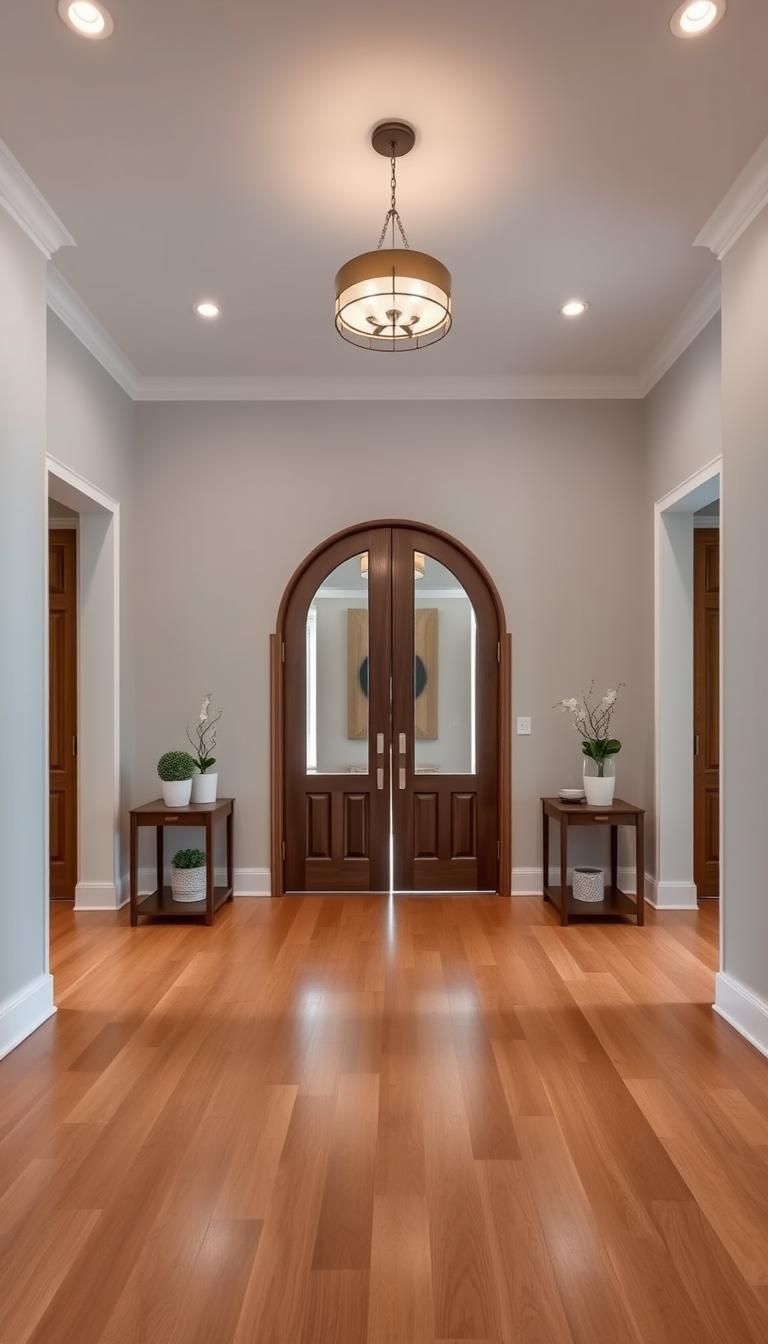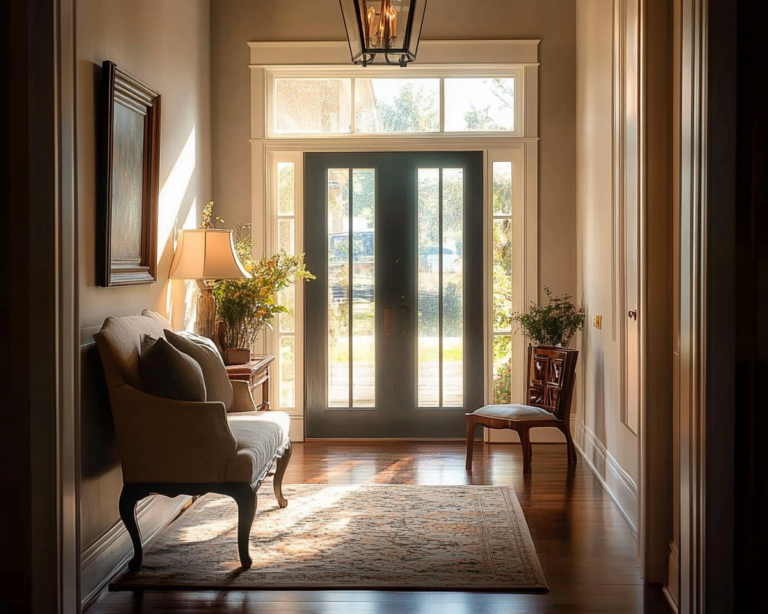How To Decorate Your Entryway To Look More Spacious
Your entryway acts as your home’s handshake – that critical moment where first impressions take shape. Whether you’re welcoming guests or returning after a long day, this transitional space sets the tone for your entire living environment. Designers like Kathleen Walsh emphasize that thoughtful details near your front door create lasting visual impact.
Strategic choices in lighting, color schemes, and functional furniture can transform cramped areas into airy, organized zones. A well-placed mirror doubles natural light, while neutral tones paired with natural wood textures establish calm sophistication. Even compact layouts gain charm through vertical storage solutions or multipurpose benches with hidden compartments.
This guide explores professional techniques to maximize your space without sacrificing personality. Discover how layered lighting fixtures elevate ambiance, why streamlined consoles maintain visual flow, and when bold accent walls add depth. We’ll break down essentials like:
– Smart furniture arrangements that enhance movement
– Reflective surfaces that amplify square footage
– Textured elements adding warmth and dimension
From apartment-friendly hacks to full-scale renovations, these ideas prove even modest entryways can radiate hospitality. Let’s reimagine your threshold as a polished introduction to your home’s unique story.
Table of Contents
Introduction
Stepping into a home should feel like a breath of fresh air, starting right at the threshold. This interior design cornerstone isn’t just about square footage—it’s about crafting a welcoming atmosphere that flows naturally into your living areas. Whether you’re working with a grand foyer or a cozy nook, smart solutions can make any space feel intentional and inviting.
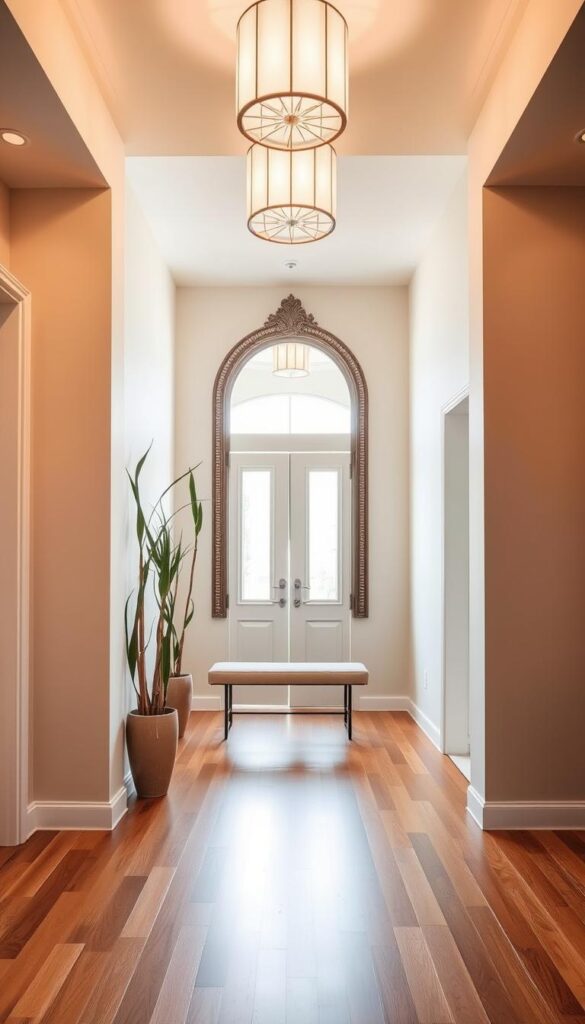
Consider how a gallery wall near the front door adds personality without clutter, or how bold tile patterns create visual intrigue. These ideas prove even modest entryways can balance practicality with style. The right blend of storage benches, statement lighting, and textured rugs turns transitional zones into curated experiences.
Below, we’ll explore:
| Design Principle | Space-Enhancing Benefit | Example |
|---|---|---|
| Vertical Storage | Frees floor area | Wall-mounted cubbies |
| Light Layering | Illuminates corners | Pendant + sconces |
| Color Continuity | Expands visual flow | Neutral hallway palette |
Your home’s entry sets expectations. By focusing on accents like sculptural hooks or a vibrant runner, you create moments that delight. Upcoming sections break down lighting tricks, mirror placements, and furniture picks—all tailored to your layout.
Ready to turn that pass-through zone into a purposeful introduction? Let’s begin.
The Impact of an Inviting Entryway
First impressions begin the moment someone crosses your threshold. A well-curated entryway doesn’t just impress guests—it creates a psychological shift from the outside world to your sanctuary. Think of it as your home’s opening chapter, setting expectations for every room beyond.
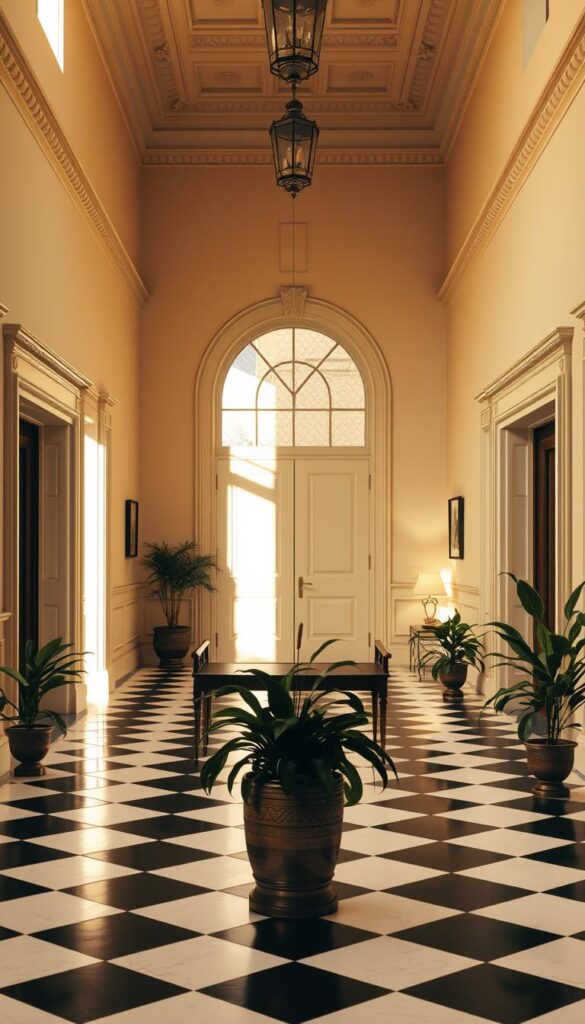
Clever design tricks make spaces feel instantly grander. Checkered flooring patterns, for instance, guide the eye outward to create depth. Pair this with layered light sources—like a pendant fixture and wall sconces—to eliminate shadows that shrink visual space.
Real transformations prove these ideas work. One redesigned foyer used black-and-white tiles to stretch a narrow layout, while floor-to-ceiling windows amplified natural brightness. Guests reported feeling energized upon entering, noting how airy the zone felt despite its compact size.
| Design Element | Visual Impact | Real-World Example |
|---|---|---|
| Checkered Flooring | Expands perceived width | 8×10 entry using alternating tiles |
| Reflective Walls | Doubles natural light | Mirrored panels beside door |
| Vertical Lighting | Lifts ceiling appearance | Brass sconces flanking art |
These choices do more than beautify—they craft experiences. A visitor stepping onto bold flooring feels the shift from mundane to intentional. Strategic layouts with clean sightlines whisper “welcome” before a single word is spoken.
Understanding Your Space & Layout
Every entryway holds untapped potential waiting to align with your home‘s architectural personality. Start by evaluating your floorplan like a detective—measure wall lengths, note door swings, and identify natural traffic patterns. Interior designer Melissa Goff suggests mapping three key zones: storage for essentials, display areas for character, and clear pathways for effortless movement.
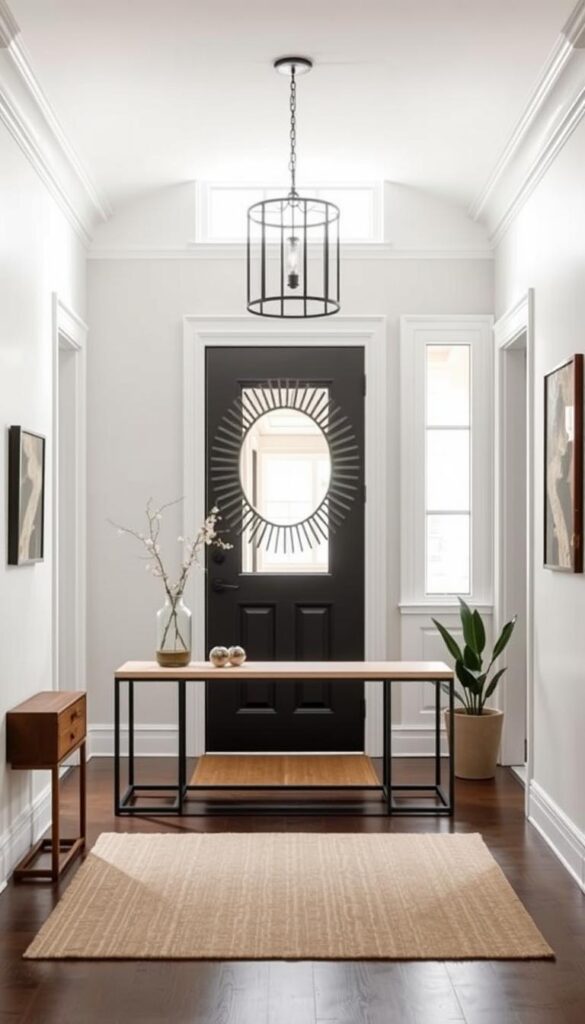
Assessing the Available Area
Grab a tape measure and sketchpad. Document ceiling heights, outlet locations, and permanent fixtures. Compact layouts thrive with slim consoles under 12″ depth, while spacious foyers can handle statement benches. Always leave 36″ of walking clearance—critical for maintaining that welcoming impression.
Designing Around Unique Architectural Features
Odd angles or exposed beams? Celebrate them. Crown molding becomes a natural frame for vertical stripes, drawing eyes upward. Sloped ceilings pair beautifully with geometric wallpaper, adding visual interest without clutter. For protruding walls, try recessed shelving that blends seamlessly into the structure.
| Design Element | Practical Benefit | Example |
|---|---|---|
| Vertical Storage | Maximizes narrow areas | Floor-to-ceiling hooks |
| Functional Zones | Organizes traffic flow | Bench with under-seat baskets |
| Accent Walls | Highlights unique features | Bold paint on sloped ceiling |
Remember, your room‘s quirks are its superpower. A well-placed mirror beside arched doorways doubles both light and charm. Let your layout guide decisions, not limit them—after all, great design works with what you have.
Expert Tips on Lighting and Color Selection
Lighting and color form the backbone of entryway design, shaping how we perceive space and atmosphere. Professional designers often treat these elements as partners—strategic combinations that elevate functionality while creating optical expansion. Let’s explore techniques used in modern homes to balance brightness and personality.
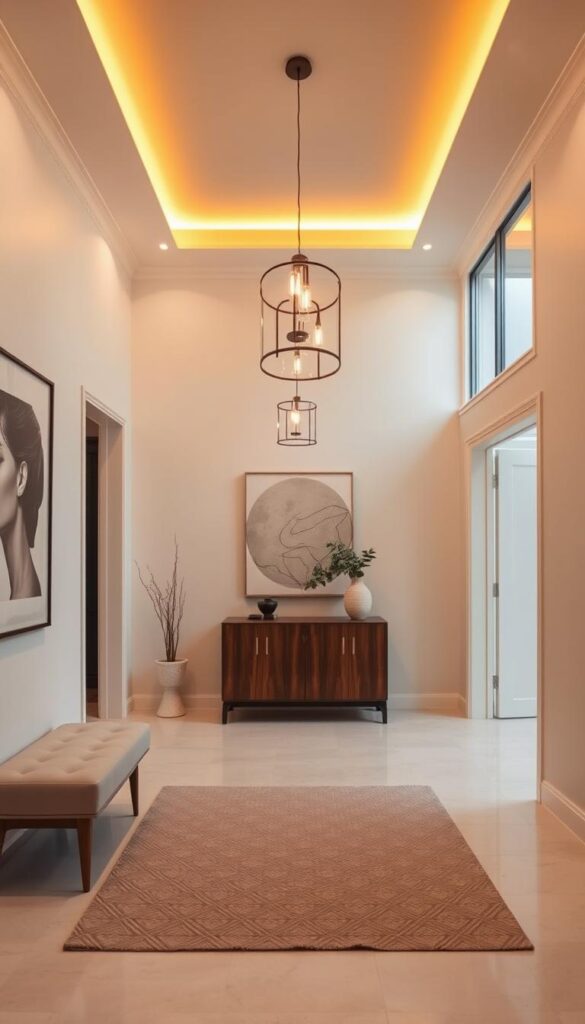
Maximizing Natural Light
Sunlight acts as your best ally. Sheer curtains or frosted window films diffuse brightness without blocking it. Position mirrors opposite windows to bounce rays deeper into your home. For artificial sources, layer 2700K-3000K bulbs in sconces with adjustable pendants.
Checkered rugs near doorways guide eyes outward, amplifying width. Designers like Studio McGee pair these with recessed ceiling lights to eliminate shadows. Always match fixture sizes to your door—a petite lantern suits narrow entries, while grand foyers demand statement chandeliers.
| Window Treatment | Light Diffusion | Style Impact |
|---|---|---|
| Sheer Panels | Soft, even glow | Airy minimalism |
| Frosted Glass | Reduced glare | Modern privacy |
| Mirrored Films | Double brightness | Luxury accents |
Choosing Light, Airy Colors
Soft neutrals like pale gray or creamy white form ideal bases. Paint ceilings 1-2 shades lighter than walls to lift visual height. For depth, add accents through bold throw pillows or glossy vases in jewel tones.
Web-favorite projects reveal clever contrasts. A Brooklyn loft used sage-green door trim against white walls, creating focal points without heaviness. Remember: monochromatic schemes with varied textures keep designs cohesive yet dynamic.
Dimmers let you shift moods effortlessly—bright for morning routines, warm for evening welcomes. Pair these ideas with metallic finishes on light fixtures to reflect every hue beautifully.
Incorporating Mirrors for a Spacious Feel
Mirrors work like magic in tight spaces, acting as instant space amplifiers. Positioned strategically, they bounce light across walls and create the illusion of depth. A classic example? A New York loft used an oversized black-framed mirror to visually double its narrow entry, proving you don’t need square footage for grandeur.
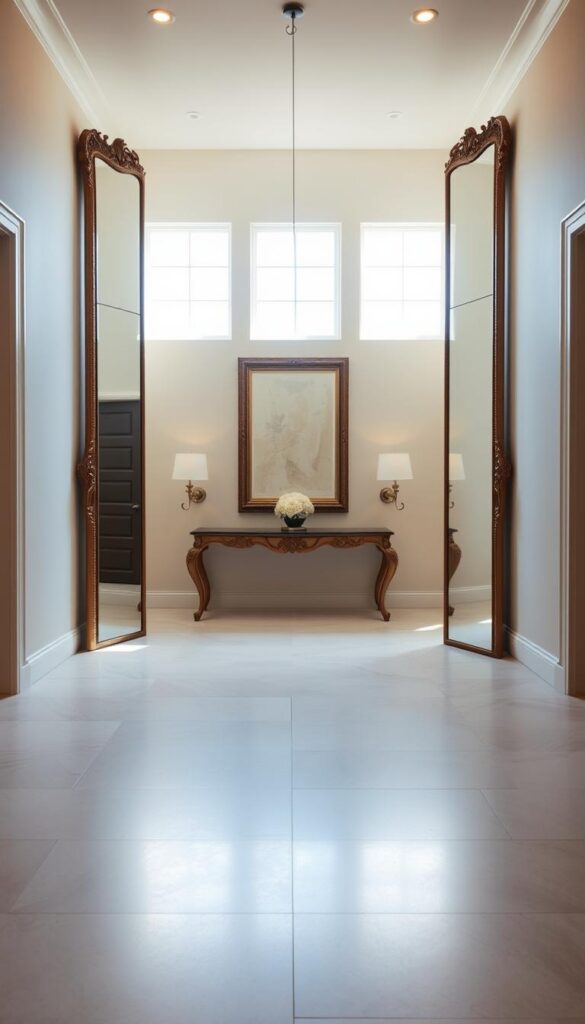
Selecting the Perfect Mirror Style
Match your home’s personality with mirror shapes and frames. Sleek, frameless designs suit modern layouts, while ornate gold-edged options add vintage charm. For farmhouse vibes, try distressed wood frames. Sunburst mirrors with metallic accents bring energy to minimalist rooms.
Placement matters most. Hang circular mirrors above consoles to soften angular spaces. Lean floor-length styles against walls to draw eyes upward. Avoid cluttering reflection areas—keep pathways clear so light travels freely.
Pair mirrors with functional pieces for balance. A console table beneath a large mirror creates a practical drop zone. Add a sculptural vase or framed art beside it to anchor the display. Designers often use this trio to blend utility with visual intrigue.
Real-world transformations show the power of smart choices. A Chicago apartment used a trio of oval mirrors along a dark hallway, instantly brightening the corridor. Another project placed a cheval mirror near the door for last-minute outfit checks—proving style and function coexist beautifully.
Creative Storage Solutions for Entryway Clutter
Taming entryway chaos starts with smart storage that marries form and function. Modern solutions prove organization doesn’t require sacrificing style—think woven baskets doubling as art pieces or floating shelves displaying favorite reads.
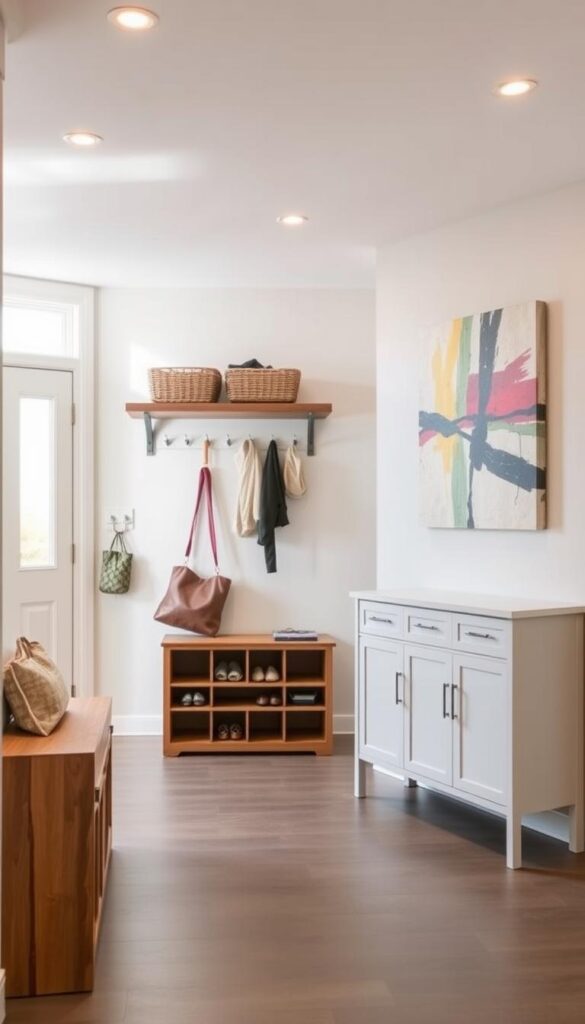
Space-Saving Innovations
Vertical storage transforms underused wall areas. A Brooklyn renovation used IKEA shelving units as shoe cubbies, saving 4 square feet of floor space. Pair these with a slim bench containing hidden compartments for seasonal accessories.
Consider these stylish fixes:
- Vintage mail organizers repurposed as vertical shoe racks
- Leather ottomans with interior dividers for gloves/hats
- Magnetic wall panels for holding keys and sunglasses
| Solution | Function | Style Boost |
|---|---|---|
| Floating Console | Holds mail + decor | Creates airy feel |
| Labeled Baskets | Conceals shoes | Adds texture |
| Rotating Boot Tray | Organizes footwear | Sleek modern look |
Web-favorite projects show how board-and-batten walls with hooks streamline coats and bags. One home used a round entry table with a built-in charging station—proving furniture can multitask beautifully.
For last-minute essentials, try a ceramic bowl on your console paired with wall-mounted hooks. These ideas keep daily clutter contained while letting your personality shine through curated displays.
Slimline Furniture & Minimal Design Choices
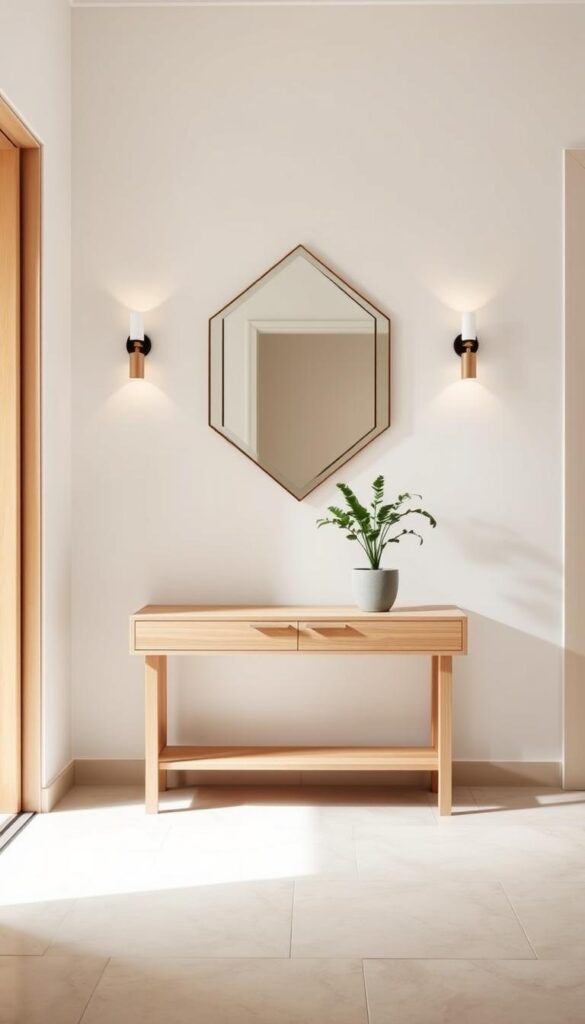
Modern living demands smart solutions that marry form and function—nowhere more crucially than in entryways. Slimline furniture has emerged as a hero in interior design, offering clean profiles that maintain visual flow. These pieces prove less truly can be more when every square foot counts.
Streamlined designs like lucite console tables or wall-mounted benches with hidden storage reduce visual noise. A Brooklyn studio showcased a 10-inch-deep floating shelf that holds keys and decor without invading walkways. Such choices let your home breathe while keeping essentials within reach.
| Furniture Type | Space-Saving Function | Style Benefit |
|---|---|---|
| Narrow Console | Mail sorting + display | Enhances depth perception |
| Ottoman with Storage | Seating + shoe concealment | Adds textural contrast |
| Lean Mirror Cabinet | Reflection + accessory storage | Doubles light sources |
Prioritize pieces that serve dual purposes. A Philadelphia renovation used a garden bench as both seating and umbrella storage. Look for materials like matte metals or light-toned woods to maintain airiness.
Minimal design thrives on intentional editing. Swap bulky coat racks for discreet wall hooks beside your entryway door. Choose a slender table with vertical drawers instead of wide cabinets. Let’s explore how intentional editing elevates daily living.
Curating Art and Bold Wall Decor
Art transforms blank walls into storytelling canvases, especially in entry areas where first impressions take root. Strategic displays add visual interest while reflecting your home’s character. Think beyond single frames—layered arrangements create depth, and unexpected pieces spark conversation.
Using Statement Art Pieces
An oversized abstract painting or vintage map instantly anchors your space. Designers often pair bold works with minimalist furniture to avoid clutter. For example, a Los Angeles loft used a 4-foot sculptural clock as both timekeeper and focal point.
Layering Artwork for Visual Interest
Mix small sketches with large canvases using a common color thread. Try floating shelves for 3D pieces like ceramic plates or woven baskets. A Seattle entryway combined family photos, pressed botanicals, and a macramé wall hanging—all within a neutral palette.
| Art Arrangement | Visual Effect | Real-World Example |
|---|---|---|
| Gallery Wall | Unifies diverse styles | Black-and-white photography grid |
| Mixed Frames | Adds eclectic charm | Gold + wood frames on olive wall |
| Oversized Piece | Creates instant drama | Textured fiber art above console |
Balance is key. Leave breathing room between pieces, and align tops or bottoms for cohesion. Pro tip: Use removable adhesive strips to test layouts before committing. Your wall becomes a dynamic introduction to what lies beyond.
Embracing Natural Materials and Textural Finishes
Natural materials whisper stories of craftsmanship while softening modern design. A Portland renovation showcased this by pairing reclaimed oak beams with a jute rug, proving sustainable choices can elevate both style and comfort. These elements ground your home’s entrance with organic warmth, inviting guests to pause and connect.
Textural contrast works magic in compact areas. Think wide-plank flooring alongside smooth plaster walls, or a chunky knit basket beside a sleek metal console. These combinations add depth without visual clutter. Designers are embracing light-toned woods like ash for floor installations—their grain patterns catch light beautifully, making spaces feel airier.
| Material | Design Benefit | Sustainable Example |
|---|---|---|
| Reclaimed Wood | Adds rustic character | Barn door console table |
| Handwoven Textiles | Softens hard surfaces | Jute entryway runner |
| Terracotta | Brings earthy tones | Planters with herbs |
Current trends favor mixing eras and origins. Try a vintage Moroccan pouf beside fresh eucalyptus stems in a modern vase. Keep arrangements minimal—one statement piece per zone maintains openness. Oak floors reflect light, while woven rugs add softness underfoot.
For those craving cohesion, choose one dominant texture and repeat it subtly. A Chicago house used vertical wood slats on walls and matching floating shelves. This repetition created rhythm without overwhelming the interior. Remember: nature’s imperfections become your home’s perfect accents.
How To Decorate Your Entryway To Look More Spacious
Transforming tight entry spaces into welcoming zones requires smart strategies that balance form and function. By blending design principles with intentional decor, even compact foyer areas can feel expansive. Let’s revisit proven methods that create lasting impressions while maximizing utility.
Vertical storage solutions like wall-mounted cubbies save 30% more floor space than traditional units, according to Samantha Ware Designs. Pair these with a slim console table under 12″ depth for mail sorting and display. Key tactics include:
- Installing large-scale artwork to draw eyes upward (Pär Bengtsson)
- Matching color palettes to adjacent rooms (Erin Shakoor)
- Using two-tone tiles for visual depth (Allison Lind)
| Element | Space Benefit | Real Example |
|---|---|---|
| Nesting Tables | Flexible surfaces | Samantha Ware’s modular units |
| Built-In Bookcases | Vertical storage | Nicholas Obeid’s corner solutions |
| Reflective Surfaces | Light expansion | Alton Bechara’s lacquer finishes |
Maintain balance by limiting wall decor to one focal point per zone. Stacy Zarin Goldberg recommends consoles with hidden drawers to conceal daily clutter. For cohesion, extend hallway runners into the entryway—a trick Erin Shakoor uses to visually connect spaces.
Personalized touches make all the difference. Try bold decor like Frederick Tang’s black tile accents or Georgia Tapert Howe’s artichoke wallpaper. Remember: your entryway should reflect your style while serving as a graceful introduction to the rest of your home.
Adding a Touch of Green: Incorporating Plants into Your Entryway
Greenery breathes life into transitional spaces, turning sterile areas into vibrant introductions. Plants like snake varieties or pothos purify air while adding organic accents that soften angular room layouts. A Chicago renovation proved this by pairing a sleek console table with cascading ivy—guests now pause to admire the natural welcome.
Low-maintenance options thrive in entry environments. Peace lilies tolerate low light, while succulents in geometric pots add modern style. Web-favorite projects use hanging planters above shoe benches or tall bamboo stalks beside doors—clever ways to maximize vertical space.
Selecting the Right Planters and Pots
Choose vessels that complement your home’s aesthetic. Rattan footed cachepots add warmth to farmhouse entryway designs, while glossy ceramic planters suit contemporary spaces. For small areas, try wall-mounted options like the Joss & Main Annarah planter—it holds herbs without cluttering walkways.
| Planter Material | Design Advantage | Ideal Plant Pairing |
|---|---|---|
| Terracotta | Natural breathability | ZZ plants |
| Metallic | Reflective surfaces | Ferns |
| Concrete | Modern minimalism | Cacti |
Maintenance matters. Self-watering systems in FRP planters keep soil moist during trips. Place greenery away from high-traffic zones—a floating shelf prevents leaf-brushing near storage baskets. Rotate plants monthly for even growth, and wipe leaves weekly to maintain vibrant color.
These ideas transform functional zones into living art displays. Whether using brass planters for elegance or woven baskets for texture, nature’s touch makes every return home feel rejuvenating.
Statement Pieces That Define the Entryway
A well-chosen statement piece can transform your threshold from ordinary to unforgettable. These space-shaping elements serve as both functional anchors and personality markers, creating lasting impressions. Think of a hand-carved teak door with brass inlays or a sculptural bench that whispers stories of craftsmanship.
Less is more here. A single oversized mirror like Fragments by am.o atelier reflects light while adding artisanal texture. Pair it with a streamlined console such as the Dolmen limestone design—its raw edges contrast beautifully with modern architecture. This balance lets each piece shine without competing.
Blend eras for depth. Try a mid-century Slyd bench seat beside industrial wall sconces. Or layer a Makemake vase’s organic curves over geometric wallpaper. These curated contrasts make your home feel collected rather than cluttered.
| Statement Piece | Design Impact | Real Example |
|---|---|---|
| Reclaimed Wood Mirror | Adds warmth + light | Fragments by am.o atelier |
| Mixed-Material Console | Creates visual anchor | Dolmen limestone table |
| Artisan Lighting | Sets mood + style | Tenfold 3 pendant light |
Functionality remains key. The Kado bench offers hidden storage beneath its marble top. For smaller areas, wall-mounted shelves like Pop by SALAK Studio display art without eating floor space. Remember: your entry should intrigue guests while serving daily needs effortlessly.
Let your centerpiece reflect what lies beyond. A bold mirror hints at curated resting areas inside, while an heirloom rug previews your color story. These intentional choices turn transitions into destinations worth savoring.
Lighting Fixtures That Transform Your Space
Lighting holds the power to reshape how we experience transitional areas. The right light fixture turns functional illumination into spatial artistry, especially in entry zones where first impressions form. A recent San Francisco project demonstrated this by swapping outdated overhead lights for brass pendant clusters, instantly elevating a cramped space into a luxurious welcome.
Modern lighting trends emphasize layered approaches. Pair recessed ceiling lights with wall sconces near your console to create depth. For high ceilings, try sculptural chandeliers like the Starburst Flush Mount—its metallic rays scatter light playfully while maintaining airiness.
| Fixture Type | Space Benefit | Real-World Application |
|---|---|---|
| Brass Pendants | Adds warmth + vertical emphasis | Clara Gold Semi Flush Mount |
| Linear Sconces | Expands narrow walls | West Elm Warren series |
| Glass Flush Mounts | Diffuses light evenly | Anthropologie Starburst design |
Strategic placement amplifies effects. Install fixtures 30″ above furniture surfaces for optimal glow. Near staircases, use cascading pendants to guide movement upward. A Boston renovation paired matte-black sconces with herringbone flooring, creating rhythm between architectural elements.
Finish choices matter. Brass accents complement wood tones in homes with traditional rugs, while nickel suits contemporary spaces. Always match hardware finishes for cohesion—think doorknobs and cabinet pulls. These thoughtful touches turn necessity into narrative, proving every watt counts.
Practical Do-It-Yourself Entryway Enhancements
Revamping your threshold doesn’t require a contractor or big budget—just creativity and elbow grease. With a few clever tweaks, you can turn cluttered corners into functional showstoppers that reflect your personality.
DIY Decor and Art Ideas
Transform old furniture into statement pieces. Sand down a thrifted console table and paint it sage green for instant charm. Use stencils to add geometric patterns to plain baskets—perfect for holding keys or mail.
Create budget-friendly wall art using fabric scraps or vintage postcards. Frame pressed leaves between glass panes for organic texture. Web favorites include gallery walls made from mismatched frames spray-painted gold.
Quick Storage and Organization Hacks
Install floating shelves above doorways for off-season accessories. Repurpose a wooden ladder as vertical storage for scarves and bags. Add adhesive hooks inside cabinet doors to hang umbrellas or leashes.
Try these space-saving solutions:
- Turn an old crate into a shoe organizer with dividers
- Use tension rods under benches for hanging hats
- Paint mason jars as brush holders for keys
| Project | Benefit | Cost |
|---|---|---|
| Pegboard Wall | Customizable storage | $25 |
| Upcycled Dresser | Hidden compartments | Free (repurposed) |
| Magnetic Spice Rack | Holds keys/wallets | $12 |
Personal touches make all the difference. Stencil your rug with bold stripes using fabric paint. Let kids decorate clay bowls for loose change. Your home’s entrance should tell your story—one DIY project at a time.
Tips from Interior Design Experts: Trends and Inspirations
Design visionaries are reimagining entry spaces as eco-conscious galleries of self-expression. Interior design leaders like Taniya Nayak emphasize balancing aesthetics with earth-friendly choices. Let’s explore fresh approaches shaping today’s most inviting thresholds.
Modern Design Trends
Current trends favor bold contrasts and functional artistry. Studio McGee’s latest projects showcase:
- Mixed metal light fixtures with geometric shapes
- Textured accent walls using 3D tiles or ribbed wood
- Floating consoles in matte black or warm walnut tones
Wendy Labrum’s Boston renovation proves small spaces shine with oversized art. She paired a 5-foot abstract canvas with a slim bamboo bench, creating visual interest without clutter.
| Trend | Designer Example | Impact |
|---|---|---|
| Biophilic Elements | Megan Pflug’s live-edge table | Connects indoors/outdoors |
| Modular Storage | Amy Fasnacht’s pegboard system | Customizable organization |
| Monochrome Palettes | Nicholas Obeid’s navy entry | Luxurious cohesion |
Sustainable Decor Inspirations
Eco-smart choices now define luxury. Havenly’s designers recommend:
- Recycled glass tile flooring from Fireclay
- Energy-efficient LED strips under floating shelves
- Vintage rug restoration using plant-based dyes
Brooklyn’s Green House Project transformed a 1920s foyer with reclaimed brick and solar-powered sconces. Their secret? “Sustainability isn’t a trend—it’s the new standard,” says lead designer Clara Jeong.
Try these instant updates tonight: Swap plastic trays for cork organizers. Install a thrifted mirror above your console. Add air-purifying snake plants in handmade ceramic pots. Your home’s entrance deserves both style and substance.
Conclusion
Crafting an inviting entryway blends smart design with personal flair—a balance that welcomes guests and reflects your home’s character. Through vertical storage solutions, layered lighting, and strategic mirror placements, even compact areas gain breathing room. These choices work together to create first impressions that linger long after visitors step through your door.
Successful transformations prove cohesive design matters. A neutral palette with bold art creates rhythm, while multifunctional furniture maintains clutter-free zones. Whether adding greenery or textured rugs, every detail contributes to spatial harmony.
Your foyer deserves to mirror your lifestyle. Experiment with floating shelves for curated displays or statement lighting that elevates ceilings. Remember—great design solves problems while sparking joy.
Ready to reimagine your threshold? Start small: swap bulky items for slim consoles, or hang a mirror to amplify light. These changes build momentum toward a room that feels both expansive and authentically yours. Your journey to an airy, intentional entry begins now.
